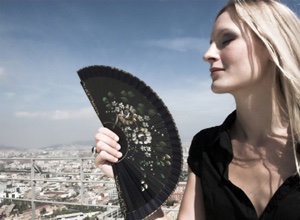The Three Main Reasons Why Women Get Hot Flushes
Hot flushes are the most common complaint for women going through menopause. Find out what’s behind them and why they occur.

It seems that hot flushes are the bane of many women’s lives at menopause – and they have quite an effect on those around them too. Hot flushes come on without any warning and can range from being mildly uncomfortable to downright unbearable.
Symptoms range from just a slight redness of the face to a full body sweat that leaves you wringing wet and generating enough heat to boil water. Then there are the dreaded night sweats which can seriously disturb your sleep.
About 75% of all women have these sudden, brief, periodic increases in their body temperature. Usually they start before a woman’s last period. For 80% of women, hot flushes occur for 2 years or less but a small percentage can experience them for more than 2 years.
How affected you are will depend on several factors, including where you live and what you eat. Some lucky women never get them at all and they are certainly very much more common in the western world. For example, there is no word in Japanese to cover this phenomenon because in Japan women do not seem to suffer from them – unless they have switched to a predominantly western diet.
The Reasons Why
Although some lucky women escape completely, there are some very good reasons why we experience the heat that we associate with menopause:
1. Blood Vessels
Hot flushes occur when the blood vessels below the skin dilate. This causes more blood to rush to the skin’s surface, and that is what makes you look red and flushed, and feel that tell-tale rise in temperature.
The body’s normal response to this is to try and cool you down, so when your body temperature increases your body immediately goes into action. And the first line of defence is usually to make you sweat.
What is unique about hot flushes is that this mechanism kicks in even when the outside temperature may be low and you do not have any signs of fever.
2. Fluctuating hormones
Well you know all about this during menopause, and in fact the changing levels of your hormones are the prime cause of hot flushes and night sweats.
When your hormone levels fluctuate they cause the temperature control mechanism in the body to be disturbed. The centre which controls this is in a part of the brain called the hypothalamus. It’s the changing levels of oestrogen and FSH (follicular stimulating hormone) that can upset this delicate balance and cause hot flushes.
Women suffering from flushes usually have decreased oestrogen levels and increased FSH levels, but it’s important to remember that it’s often the changes in hormone levels – rather than the actual amount of hormone being produced – that produces hot flushes.
3. Surgical menopause
It’s to be expected that menopause symptoms come naturally when a woman’s childbearing years are coming to a close and the menopause or perimenopause is under way.
However, women who have a hysterectomy or their ovaries removed at an age when they would not normally be going through menopause are more likely to experience more severe and frequent hot flushes after the surgery than in a natural menopause transition.
Even if the ovaries are retained it’s no guarantee that an early menopause will not occur, as their effectiveness at producing progesterone will be affected and will diminish over time.
Helpful information
There’s no doubt that hot flushes can be seriously disruptive so anything you can do to make your life easier will put you more in control.
A good diet, moderate exercise and low stress levels are the place to start and addressing hormone imbalances will make a huge difference too.
https://anna.blog.wellsprings-health.com/how-to-help-your-menopause-symptoms/


















